Table of Contents
ToggleNCERT Solutions Class 10 Science Chapter 3 (Metals and Non Metals)
NCERT Solutions for Class 10 Science Chapter 3 Intext Questions
NCERT Solutions Class 10 Science Chapter 3 (Metals and Non Metals)
Page Number: 40
Question 1
Give an example of a metal which
(a) is a liquid at room temperature
(b) Can be easily cut with a knife !
(c) is the best conductor or heat
(d) is the poorest conductor of heat.
Answer:

Question 2
Explain the meaning of malleable and ductile.
Answer:

NCERT Solutions Class 10 Science Chapter 3 (Metals and Non Metals)
Page Number: 46
Question 1
Why is sodium kept immersed in kerosene oil?
Answer:

Question 2
Write equations for the reactions of
(i) iron with steam.
(ii) calcium and potassium with water.
Answer:

Question 3
Samples of four metals A, B, C and D were taken and added to the following solution one by one.
The results obtained have been tabulated as follows :
Use the Table above to answer the following questions about metals A, B, C and D.
(i) Which is the most reactive metal ?
(ii) What would you observe if B is added to a solution of copper (II) sulphate?
(iii) Arrange the metals A, B, C and D in the order of decreasing reactivity.
Answer:
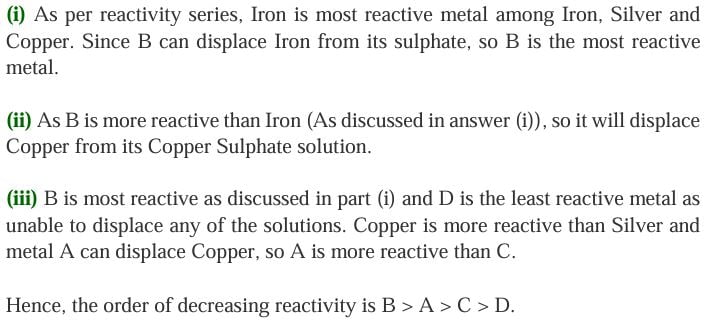
Question 4
Which gas is produced when dilute hydrochloric acid is added to a reactive metal ? Write the chemical reaction when iron reacts with dilute H2SO4.
Answer:

Question 5
What would you observe when zinc is added to a solution of iron (II) sulphate ? Write the chemical reaction that takes place.
Answer:

NCERT Solutions Class 10 Science Chapter 3 (Metals and Non Metals)
Page Number: 49
Question 1
(i) Write the electron dot structures for sodium, oxygen and magnesium.
(ii) Show the formation of Na2O and MgO by the transfer of electrons.
(iii) What are ions present in these compounds?
Answer:

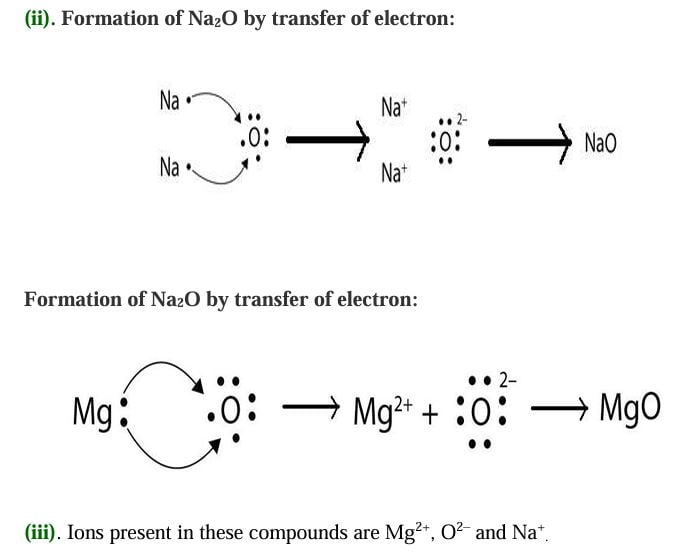
Question 2
Why do ionic compounds have high melting – points?
Answer:

NCERT Solutions Class 10 Science Chapter 3 (Metals and Non Metals)
Page Number: 53
Question 1
Define the following terms:
(a) Minerals
(b) Ores
(c) Gangue
Answer:
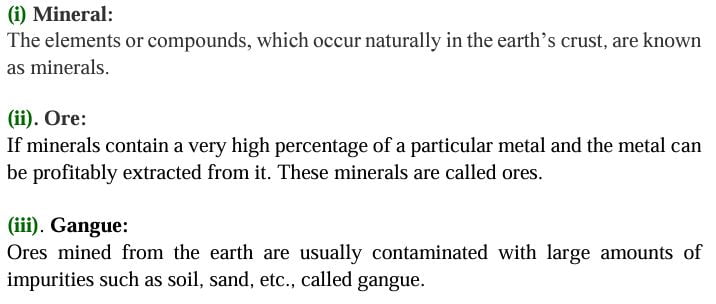
Question 2
Name two metals which are formed in nature in free state.
Answer:

Question 3
What chemical process is used for obtaining a metal from its oxide.
Answer:
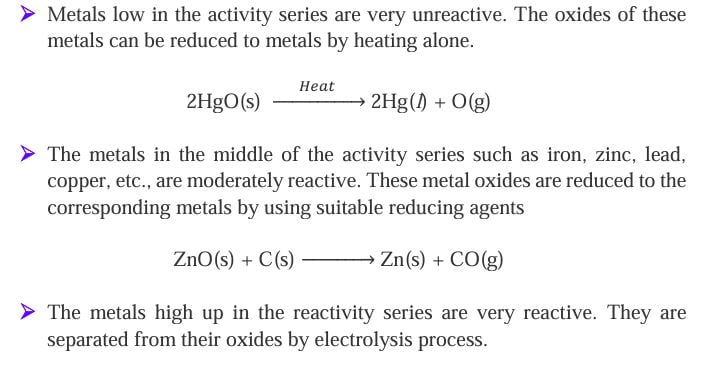
NCERT Solutions Class 10 Science Chapter 3 (Metals and Non Metals)
Page Number: 55
Question 1
Metallic oxides of zinc, magnesium and copper were heated with the following metals.
In which cases, will you find displacement reactions taking place?
Answer:

Question 2
Which metals do not corrode easily?
Answer:

Question 3
What are alloys?
Answer:

NCERT Solutions for Class 10 Science Chapter 3 Exercise Questions (Textbook Chapter End Questions)
NCERT Solutions Class 10 Science Chapter 3
Question 1
Which of the following pairs will give displacement reactions ?
(a) NaCl solution and copper metal.
(b) MgCl2 solution and aluminium metal.
(c) FeSO4 solution and silver metal.
(d) AgNO3 solution and copper metal.
Answer:
Question 2
Which of the following methods is suitable for preventing an iron frying pan from rusting ?
(a) Applying grease
(b) Applying paint.
(c) Applying a coating of zinc
(d) All the above.
Answer:

Question 3
An element reacts with oxygen to give a compound with a high melting point. This compound is also soluble in water. The element is likely to be
(a) calcium
(b) carbon
(c) silicon
(d) iron
Answer:
Question 4
Food cans are coated with tin and not with zinc because
(a) zinc is costlier than tin
(b) zinc has a higher melting point than tin
(c) zinc is more reactive than tin
(d) zinc is less reactive than tin.
Answer:

Question 5
You are given a hammer, a battery, a bulb, wires and a switch:
(a) How could you use them to distinguish between samples of metals and non-metals?
(b) Assess the usefulness of these tests to distinguish between ,metals and non-metals.
Answer:

Question 6
What are amphoteric oxides? Give examples of two amphoteric oxides.
Answer:

Question 7
Name two metals which can displace hydrogen from dilute acids and two metals which cannot do so.
Answer:

Question 8
In the electrolytic refining of metal M, name anode, cathode and electrolyte.
Answer:

Question 9
Pratyush took sulphur powder on a spatula and heated it. He collected the gas evolved by inverting a test tube over it, as shown in the figure.
(a) What will be the action of gas on
(i) dry litmus paper ?
(ii) moist litmus paper ?
(b) Write a balanced chemical equation for the reaction taking place.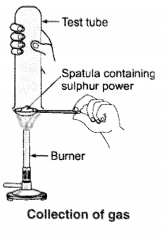
Answer:

Question 10
State two ways to prevent rusting of iron.
Answer:

Question 11
What types of oxides are formed when non-metals combine with oxygen?
Answer:

Question 12
Give reasons for the following:
(a) Platinum, gold and silver are used to make jewellery.
(b) Sodium, potassium and lithium are stored under oil.
(c) Aluminium is a highly reactive metal but still used for making cooking utensils.
(d) Carbonate and sulphide ores are usually converted into oxides during the process of extraction.
Answer:
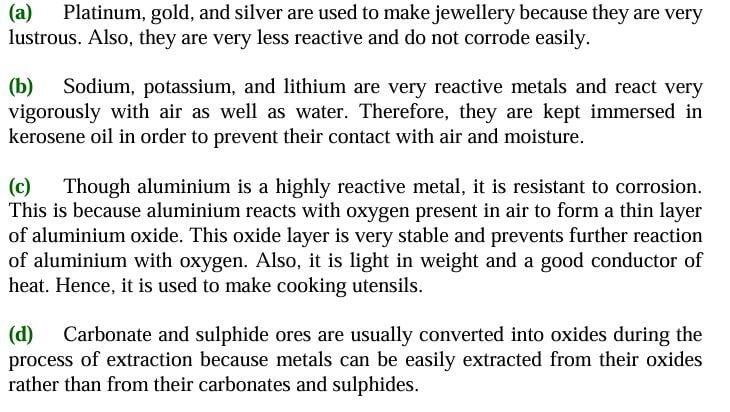
Question 13
You must have seen tarnished copper vessels being cleaned with lemon or tamarind juice. Explain why these sour substances are effective in cleaning the vessels.
Answer:

Question 14
Differentiate between metal and non-metal on the basis of their chemical properties.
Answer:
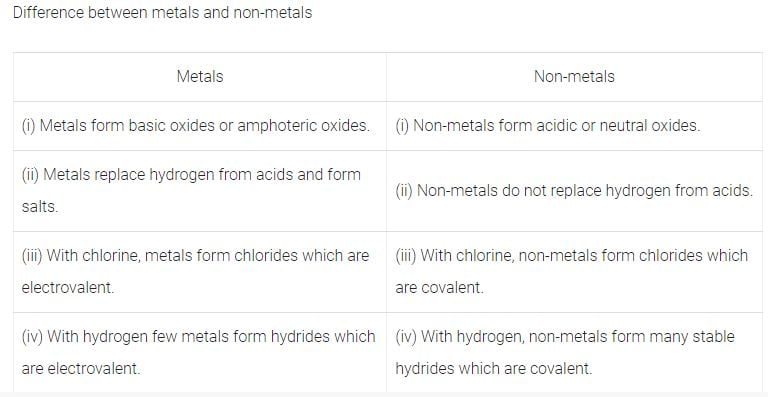
Question 15
A man went door to door posing as a goldsmith. He promised to bring back the glitter on dull gold ornaments. An unsuspecting lady gave a set of gold bangles to him which he dipped in a particular solution. The bangles sparkled like new but their weight was reduced drastically. The lady was upset but after a futile argument the man beat a hasty retreat. Can you play the detective to find out the nature of the solution he had used?
Answer:

Question 16
Give reason why copper is used to make hot water tanks and not steel (an alloy of iron).
Answer:

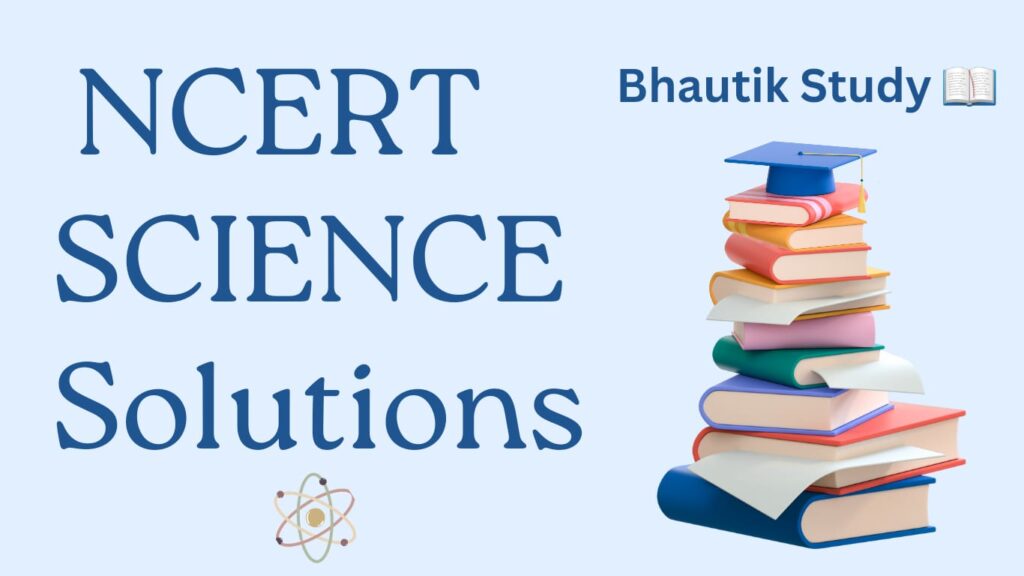
NCERT Solutions Class 10 Science Chapter 3 Metals and Non Metals Provided by Bhautik Study covers all the essential subjects in great detail to aid in students’ comprehension of the material. NCERT Solutions Class 10 Science Chapter 3 Chemical Reactions and Equations NCERT Solutions are required reading for students getting ready for their exams. You can review the entire syllabus and earn more marks by using the answers to all of the Chapter 3: Chemical Reactions and Equations Exercise Questions.
Let’s take a quick look at a list of themes and subtopics under NCERT Solutions Class 10 Science Chapter 3 Metals and Non Metals before delving into the specifics of the NCERT Solutions Class 10 Science Chapter 3 Chemical Reactions and Equations:
1) Equations And Chemical Reactions
2) Chemical Formulas
3) Chemical Reaction Types
4) Have You Noticed How Oxidation Reactions Affect Your Daily Life? Y Life?
Characteristics of NCERT Solutions Class 10 Chapter 3 Science Pupils might receive extensive instruction in balancing various types of equations.
-With the help of the CBSE Class 10 Chemistry learning tools, discover how to write a balanced chemical equation and learn about chemical reactions.
-You can write different chemical equations correctly with the aid of NCERT Solution. aids in providing you with extensive practice answering questions of various levels of difficulty before the main exam.
-When completing homework assignments and getting ready for tests, our extensive collection of study materials serves as an ideal roadmap.
-Our specialists at Bhautikstudy.com help you learn chemistry by providing CBSE Class 10 Chemistry notes, MCQs, and NCERT solutions that follow the most recent syllabus.
By using the Bhautikstudy.com NCERT Solutions Learning App on your smartphone, you can access free conceptual videos and LIVE master classes. Learn the NCERT Solutions Class 10 Science Chapter 3 (Metals and Non Metals) NCERT Book Solution in detail from knowledgeable science instructors.
Having a thorough understanding of the material and practicing will help you get 100% on the questions in this chapter. It’s now simple to learn the principles of chemistry in CBSE Class 10.
We hope that this comprehensive set of NCERT Solutions will be useful to you now that you have all the information you need to solve the Chemical Reactions NCERT Solutions Science Chapter 3 problems. Bhautikstudy.com offers free access to NCERT Books, CBSE Syllabus, CBSE Sample Papers, and RD Sharma Solutions for students.
Excellent study materials are required for students studying in Class 10 CBSE Chemistry Chapter 3 Metals and Non Metals, according to NCERT Solutions Class 10 Science Chapter 3. Subject matter specialists at Bhautik Study have created these NCERT Solutions in accordance with the most recent CBSE Syllabus. It is crucial that students use NCERT Solutions Class 10 Science Chapter 3 to assist them learn how to solve and study so they can become familiar with the kinds of questions that are posed in the chapter as well as chemical reactions and equations.
The key topics covered in Chapter 3 of NCERT Solutions Class 10 Science Chapter 3 are creating chemical equations and writing and balancing equations. Additionally, students study the fundamentals of chemical reactions in this chapter, along with their various varieties and the practical applications of chemical oxidation reactions. An summary of the chapter’s key ideas is given in the NCERT Solutions Class 10 Science Chapter 3, which also helps students become knowledgeable about crucial subjects like creating and balancing chemical equations.
There are about four problems from Science Chapter 3 of the Class 10 NCERT Solutions each year, and they carry a good weight. The majority of the questions in this chapter are practice-based questions.
In our daily lives, chemical reactions are significant phenomena. Numerous chemical reactions occur in daily life, such as the rusting of iron, the curdling of milk, respiration, digestion, and development. Students need to practise using this NCERT Solution Class 10 Science Chapter 3 in order to do well on the CBSE Class 10 test.